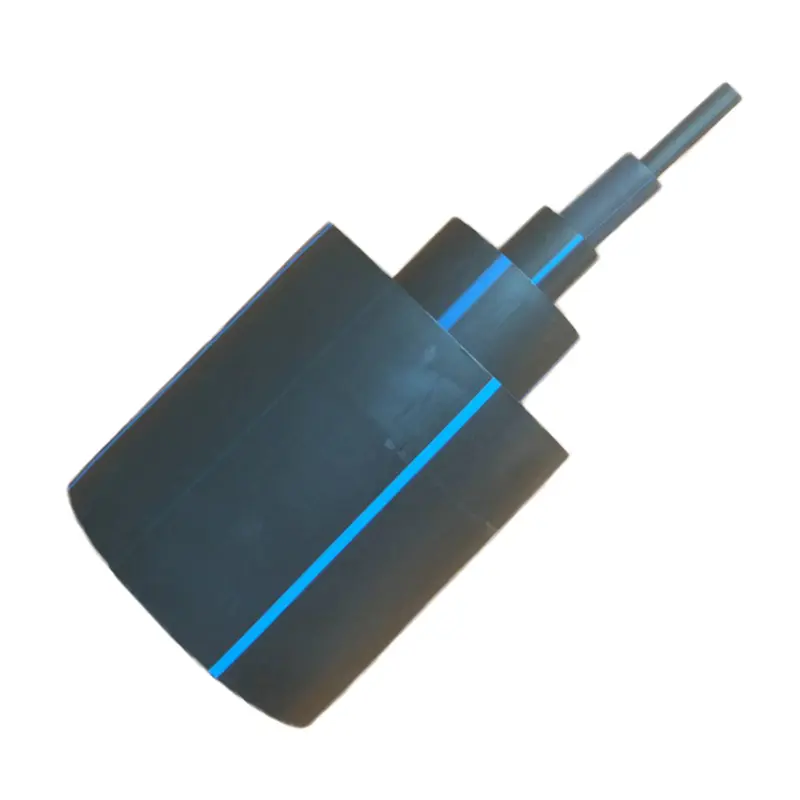Regarding hdpe pipe, we not only have 200mm hdpe pipe parameters, but also provide hdpe pipes with various other parameters. The following table is the hdpe pipe water pipe parameters, for reference only.
| Specification PE80 | Specification PE100 | ||||||||||
| dn(mm) | SDR | dn(mm) | SDR | ||||||||
| SDR33 | SDR21 | SDR17 | SDR13.6 | SDR11 | SDR26 | SDR21 | SDR17 | SDR13.6 | SDR11 | ||
| PN,Mpa | PN,Mpa | ||||||||||
| 0.4 | 0.6 | 0.8 | 1.0 | 1.25 | 0.6 | 0.8 | 1.0 | 1.25 | 1.6 | ||
| en(mm) | en(mm) | ||||||||||
| 0.4 | 0.6 | 0.8 | 1.0 | 1.25 | 0.6 | 0.8 | 1.0 | 1.25 | 1.6 | ||
| 25 | - | - | - | - | 2.3 | 32 | - | - | - | - | 3.0 |
| 32 | - | - | - | - | 3.0 | 40 | - | - | - | - | 3.7 |
| 40 | - | - | - | - | 3.7 | 50 | - | - | - | - | 4.6 |
| 50 | - | - | - | - | 4.6 | 63 | - | - | - | 4.7 | 5.8 |
| 63 | - | - | - | 4.7 | 5.8 | 75 | - | - | 4.5 | 5.6 | 6.8 |
| 75 | - | - | 4.5 | 5.6 | 6.8 | 90 | - | 4.3 | 5.5 | 6.7 | 8.2 |
| 90 | - | 4.3 | 5.5 | 6.7 | 8.2 | 110 | 4.2 | 5.3 | 6.6 | 8.1 | 10.0 |
| 110 | - | 5.3 | 6.6 | 8.1 | 10.0 | 125 | 4.8 | 6.0 | 7.4 | 9.2 | 11.4 |
| 125 | - | 6.0 | 7.4 | 9.2 | 11.4 | 140 | 5.4 | 6.7 | 8.3 | 10.3 | 12.7 |
| 140 | 4.3 | 6.7 | 8.3 | 10.3 | 12.7 | 160 | 6.2 | 7.7 | 9.5 | 11.8 | 14.6 |
| 160 | 4.9 | 7.7 | 9.5 | 11.8 | 14.6 | 180 | 6.9 | 8.6 | 10.7 | 13.3 | 16.4 |
| 180 | 5.5 | 8.6 | 10.7 | 13.3 | 16.4 | 200 | 7.7 | 9.6 | 11.9 | 14.7 | 18.2 |
| 200 | 6.2 | 9.6 | 11.9 | 14.7 | 18.2 | 225 | 8.6 | 10.8 | 13.4 | 16.6 | 20.5 |
| 225 | 6.9 | 10.8 | 13.4 | 16.6 | 20.5 | 250 | 9.6 | 11.9 | 14.8 | 18.4 | 22.7 |
| 250 | 7.7 | 11.9 | 14.8 | 18.4 | 22.7 | 280 | 10.7 | 13.4 | 16.6 | 20.6 | 25.4 |
| 280 | 8.6 | 13.4 | 16.6 | 20.6 | 25.4 | 315 | 12.1 | 15.0 | 18.7 | 23.2 | 28.6 |
| 315 | 9.7 | 15.0 | 18.7 | 23.2 | 28.6 | 355 | 13.6 | 16.9 | 21.1 | 26.1 | 32.2 |
| 355 | 10.9 | 16.9 | 21.1 | 26.1 | 32.2 | 400 | 15.3 | 19.1 | 23.7 | 29.4 | 36.3 |
| 400 | 12.3 | 19.1 | 23.7 | 29.4 | 36.3 | 450 | 17.2 | 21.5 | 26.7 | 33.1 | 40.9 |
| 450 | 13.8 | 21.5 | 26.7 | 33.1 | 40.9 | 500 | 19.1 | 23.9 | 29.7 | 36.8 | 45.4 |
| 500 | 15.3 | 23.9 | 29.7 | 36.8 | 45.4 | 560 | 21.4 | 26.7 | 33.2 | 41.2 | 50.9 |
| 560 | 17.2 | 26.7 | 33.2 | 41.2 | 50.9 | 630 | 24.1 | 30.0 | 37.4 | 46.3 | 57.2 |
| 630 | 19.3 | 30.0 | 37.4 | 46.3 | 57.2 | 710 | 27.2 | 33.9 | 42.1 | 52.2 | - |
| 710 | 21.8 | 33.9 | 42.1 | 52.2 | - | 800 | 30.6 | 38.1 | 47.4 | 58.8 | - |
| 800 | 24.5 | 38.1 | 47.4 | 58.8 | - | 900 | 34.4 | 42.9 | 53.3 | - | - |
| 900 | 27.6 | 42.9 | 53.3 | - | - | 1000 | 38.2 | 47.7 | 59.3 | - | - |
| 1000 | 30.6 | 47.7 | 59.3 | - | - | 1200 | 45.9 | 57.2 | 67.9 | - | - |
| 1200 | 36.7 | 57.2 | 67.9 | - | - | 1400 | 53.5 | 66.7 | 82.4 | - | - |
| 1400 | 42.9 | 66.7 | 82.4 | - | - | 1600 | 61.2 | 76.2 | 94.1 | - | - |
| 1600 | 49.0 | 76.2 | 94.1 | - | - | ||||||
Our products are directly supplied by the factory. For customers who want to know about hdpe pipe production, you can click the picture below to watch the factory production video of hdpe pipe.
Pros in renewable energy systems
HDPE pipe plays an important role in the success and efficiency of renewable energy systems. Among them, among the hdpe pipes with many parameters, 200mm hdpe pipes are more commonly used in renewable energy systems.
Here are some of the ways HDPE pipe contributes to the development of renewable energy
1. Efficient fluid transfer
200mm hdpe pipe ensures the high efficiency of fluid delivery. HDPE pipes have a large diameter of 200 mm for efficient, high-volume fluid transfer in renewable energy systems. They can handle large volumes of flow, ensuring the smooth flow of renewable energy sources such as geothermal fluids, biofuels, and even water in hydropower applications.
2. Durability and reliability
HDPE pipe is known for its exceptional durability and long-term reliability. They have high tensile strength and are impact, abrasion and chemical resistant. This durability ensures the integrity of fluid delivery systems, minimizes the risk of leaks or interruptions, and increases the overall efficiency of renewable energy operations.
3. Flexibility and versatility
HDPE piping offers flexibility and versatility, allowing for easier installation and adaptation to various project requirements. The 200mm diameter hdpe pipe provides a balance between flow and practical installation, making it suitable for both large and small renewable energy systems. Their flexibility allows them to maneuver around obstacles, follow terrain contours and adapt to changes in direction, making them ideal for complex installations.
4. Low maintenance requirements
HDPE pipe has a smooth inner surface that reduces friction and requires no frequent maintenance or cleaning. This feature ensures consistent fluid flow and minimizes the risk of clogging or clogging in renewable energy systems. The low maintenance requirements of this 200mm diameter HDPE pipe contribute to the overall operational efficiency and cost-effectiveness of renewable energy projects.
5. Resistance to environmental factors
HDPE pipes exhibit excellent resistance to UV radiation, weathering and harsh environmental conditions. They can withstand temperature changes, extreme weather events and prolonged exposure to sunlight without degradation. This resistance ensures long-term performance and reliability of the pipe, making it suitable for outdoor installation of renewable energy systems.
6. Environmental Sustainability
Like all HDPE pipes, HDPE pipes are environmentally friendly and recyclable. They have a low carbon footprint and contribute to the sustainability goals of renewable energy systems. Choosing HDPE pipe is consistent with the principles of eco-consciousness and facilitates the transition to a greener, more sustainable future.
In conclusion, the use of HDPE piping in renewable energy systems can improve fluid transfer efficiency, ensure durability and reliability, provide installation flexibility, reduce maintenance requirements, withstand environmental factors, and contribute to environmental sustainability. These properties make HDPE piping an essential component in the success and efficiency of renewable energy projects. Selecting 200mm hdpe pipe will ensure the successful performance of the renewable energy system. For other parameters of hdpe pipe, please refer to the product parameter table in this article.
Solutions to challenges
Renewable energy installations are constantly confronted by nature's unrelenting forces, from extreme heat to freezing cold, from intense UV radiation to harsh chemicals. In these demanding environments, material selection becomes critical. This section explores how HDPE (High Density Polyethylene) piping can be a resilient solution to withstand the challenges of extreme weather conditions and harsh environments in renewable energy systems.
200mm HDPE pipe is ideally suited to meet the challenges of extreme weather conditions and harsh environments in renewable energy installations.
Here's how they tackled these challenges:
1. Temperature resistance
HDPE pipes have excellent temperature resistance and can withstand extreme high and low temperatures. They can operate efficiently in extreme heat or cold, making them suitable for renewable energy systems located in different climates.
2. Anti-UV
HDPE pipe is designed with UV inhibitors to protect it from damaging sunlight. This UV resistance prevents degradation and ensures long-term performance of the pipe, even in areas with high sun exposure.
3. Chemical resistance
Pipes are highly chemical resistant, allowing them to withstand harsh environments where corrosive substances are present. This resistance ensures that piping remains intact and functional, even in applications involving corrosive elements or chemical processes.
4. Impact resistance and abrasion resistance
HDPE pipe is highly resistant to impact and abrasion, making it suitable for installation in rough terrain or in areas prone to physical damage. They can withstand external forces and maintain structural integrity, minimizing the risk of leakage or failure.
5. Frost and frost resistance
HDPE pipes have excellent frost and frost resistance. Their flexibility allows them to expand and contract without cracking or cracking, ensuring reliable fluid transfer even in freezing temperatures. This makes them suitable for renewable energy systems operating in cold climates.
6. Environmental stress crack resistance
HDPE pipe is inherently resistant to environmental stress cracking, which can occur due to a combination of environmental factors such as temperature changes, chemical exposure, and mechanical stress. This resistance ensures that the pipe maintains its performance and integrity over time.
7. Waterproof, leak-free joints
HDPE tubing features heat-fused joints to create a continuous, leak-free pipe. This eliminates the risk of water ingress or leakage, maintaining the integrity of the renewable energy system and preventing damage from water infiltration.
8. Longevity and durability
HDPE pipe has a long service life and excellent durability, allowing it to withstand harsh environments and extreme weather conditions. They can withstand the challenges of wind, rain, snow and other environmental elements to ensure long-term reliable operation.
By combining its temperature resistance, UV resistance, chemical resistance, impact resistance, frost resistance and other beneficial properties, HDPE pipes demonstrate their ability to meet the challenges associated with extreme weather conditions and harsh environments in renewable energy installations.
In conclusion, HDPE pipes serve as a vital link in the chain of renewable energy systems. Their ability to overcome challenges, deliver consistent performance, and contribute to environmental sustainability makes them an indispensable component in the quest for a greener future. With 200mm HDPE pipes, renewable energy systems can power ahead, supported by reliable and resilient infrastructure.

744.webp)
815.webp)
495.webp)

476.webp)
420.webp)
720.webp)


294.webp)
146.webp)


